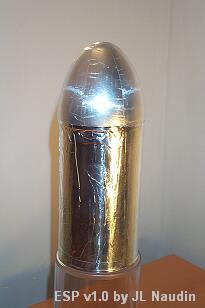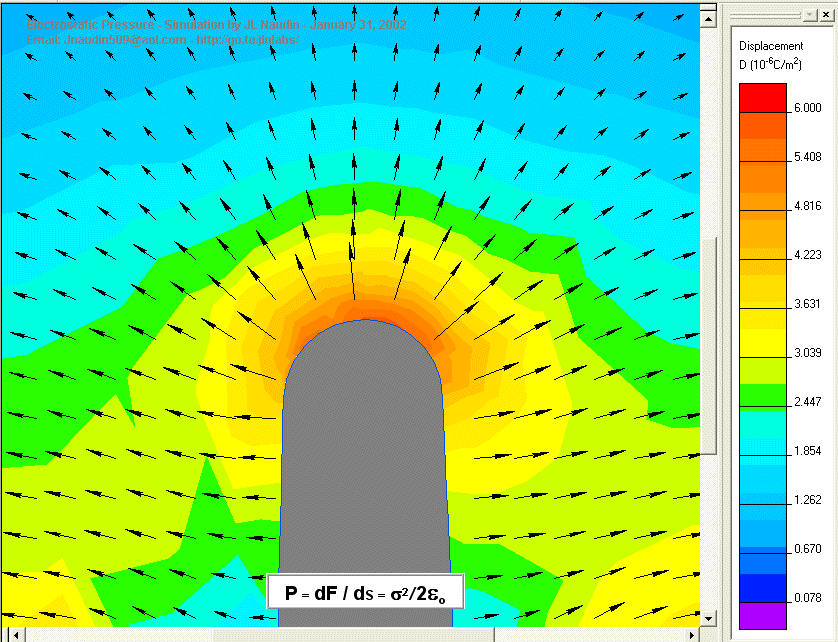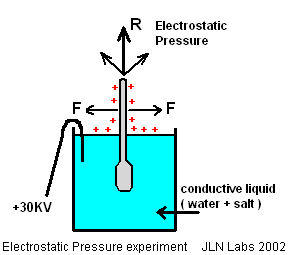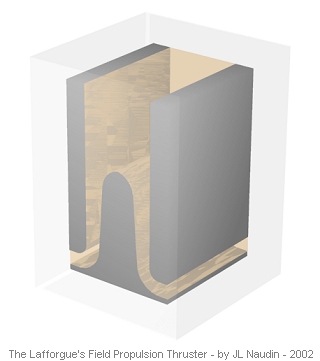

Electrostatic
pressure on a charged body
ESP
v1.0
by Jean-Louis
Naudin
created on January
20, 2002 - JLN Labs - Last
update February 3, 2002
All
informations in this page are published free and are intended for
private/educational purposes and not for commercial applications
The purpose of this experiment is to check if an asymmetrically shaped and charged body is able to produce a thrust itself along one of its axis. This thust is produced by an asymmetrical electrostatic pressure Vs the external referential (the Universe), this is the so called "Expansion Force" by Jean- Claude Lafforgue in his patent FR 2651388.
Tested apparatus description :
I have built a body fully covered by an aluminum sheet, so that the E-Field inside is equal to zero. This is a cylinder with an ogival shape at one of its extremities while the other is flat. This conductive body, the ESP v1.0, is placed on plastic cylinder base ( 200 mm ) so as to be fully isolated from the beam balance which serves to measure the upward force. A +30KV DC power supply is connected to the ESP through a thin copper wire. If an asymmetrical electrostatic pressure is produced due the special shape of the ESP, it is possible to observe a resulting force along its main axis. To check this fact, the ESP has been placed on a beam balance and two tests have been conducted for checking the resulting thrust along its two axles ( horizontal and vertical ) while it is charged through a High Voltage power supply.

The
ESP v1.0 specifications
|
TESTS RESULTS with a cylindrical conductive body :
When the ESP v1.0 is layed on its side ( symmetrical electrostatic pressure setup ), is charged with the +30 KV DC, there is no measurable thrust upward.

TESTS RESULTS with a spherical conductive body :
I have also conducted the test with a spherical conductive body. When the pherical conductive body is charged with the +30 KV DC, there is no measurable thrust upward.

The ESP has been placed in a vertical position so has to have the ogival shape at the top.

TESTS RESULTS :
When the ESP v1.0, placed vertically ( asymmetrical electrostatic pressure setup as shown in the photo above ), is charged with the +30 KV DC, there is a net thrust upward. The thrust upward is independant of the polarities and remains as long as the ESP is electrostatically charged. The leakage current is very weak ( 3 uA ) at +/-30 KV DC and the measured upward thrust about 0.2 g.
Comments : This experiment confirms that an asymmetrically shaped body is able to generate a thrust along its main axis when it is charged and when the electrostatic pressure is asymmetrical.
See the video of the Electrostatic pressure on a charged body experiment
To see the videos, the free
downloadable RealPlayer is required ![]()
Click on the picture above to see the video ( 347 Kb )

Some documents references :
 FR Patent N°2651388 "Isolated systems self-propelled by
electrostatic forces"
by Lafforgue Jean-Claude - March 1, 1991
FR Patent N°2651388 "Isolated systems self-propelled by
electrostatic forces"
by Lafforgue Jean-Claude - March 1, 1991See also :
 The Lafforgue's
Electrostatic Pressure experiment
The Lafforgue's
Electrostatic Pressure experiment
 The
LFPT explained : Theory and Principle
The
LFPT explained : Theory and Principle
![]() Email : JNaudin509@aol.com
Email : JNaudin509@aol.com
Return to the LFPT home page